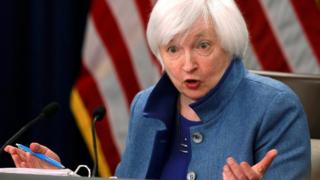 Image copyright Reuters
Image copyright Reuters it Was a measure long overdue, that does not mean it is welcome everywhere.
The decision of the U.s. Federal Reserve (FED) to increase the interest rate in that country in a quarter of a point (in the range between 0,25%-0,50% between 0,50%-0,75%) “is a vote of confidence” in the economy of the country.
So what justified the president of the FED, Janet Yellen, who also spoke of “the considerable progress made by the economy toward the two objectives of maximum employment and price stability”.
And, although chair Yellen avoided to refer to this, analysts agree that it is also a way to prepare for the government, starting in January, Donald Trump.
Trump promises to put in place a stimulus plan and construction of infrastructure that could overheat the economy and trigger a resurgence of inflation.
But as will bring new challenges to Latin american economies expected by economists polled by the BBC.
Although this is only the second increase in the past 10 years and its scope is modest, occurs in a moment in which many countries of the region are still struggling with rates of economic growth relatively low.
The FED’s decision was taken by unanimity of its members, and it is estimated that may be followed by further increases in 2017.
recession Effect
“it’s Going to have negative consequences,” said economist Oscar Ugarteche, a member of the Institute of Economic Investigations of the National Autonomous University of Mexico, in conversation with BBC World.
Stated that the rise of interest rates in the united States will drive down the price of raw materials, which will reduce the value of exports and will impact the growth of the Gross Domestic Product of many countries of the region.
The expert part of the course that after this increase of the rates of interest will come new increases in the coming months.
This possibility was advanced by the Federal Reserve that suggested in its economic projections released Wednesday, the rate for federal funds could rise to 1.4% in 2017; to 2.1% in 2018, to be located at 2.9% in 2019.
Ugarteche said that the second effect of the FED’s decision will be the increase of interest rates in many of the countries of Latin America to avoid that the dollar deposits of foreign investors to leave the country.
This, he warned, would have another consequence unwanted. “The central banks are going to raise interest rates, with which the domestic consumption will stagnate. Then, you have a second recession effect through the consumption“, he added.
Samar Maziad, vice president and senior analyst at the rating agency Moody’s, said that the measure will create a tension in some countries of Latin America, who live in a slowdown of the economy.
“The use of the monetary policy will be challenged by the existence of higher interest rates in the international markets, because in these countries they would like to remain attractive for investors,” he said in conversation with BBC World.
Financing more expensive
Maziad said that the decision of the FED will also have an impact on the cost that will have to assume the countries use external funding.
“we Hope that it will produce more interest-rate increases in 2017 which will affect the borrowing costs for emerging markets in general,” he said.
The expert indicated that it is not so much the impact of this increase of a quarter of a point in the interest rate american, but what we mean these increases in the risk premium have to pay for financed emerging markets and whose increase may occur during the coming weeks and months as investors adjust their portfolios.
“Countries that depend on international markets to finance the fiscal deficit, or that have current account deficits, relatively large will face greater difficulties to lower their own interest rates in a context of higher rates in the international markets,” said Maziad.
he Stressed that, in general, countries that are more integrated in the capital markets could see how the volatility affects the exchange rate and pointed out that it is a phenomenon that recently hit Mexico.
In that sense, Ugarteche pointed out to Mexico and Brazil as the two countries of the region more exposed to the effects of increased interest rates agreed upon by the FED.
“Are what have the greatest volume of short-term capital tucked in their bags of values, through treasury bonds issued in national currency”.
“Colombia is also going to be very affected because it has a very large amount of bonds issued in national currency with foreign capital, despite the fact that in absolute terms is a small amount, but for the colombian economy is an amount large”, he added.
But, Ugarteche goes beyond.
“Listening to speak to the president-elect Donald Trump I see a horizon in which the government steps on the gas tax with a large infrastructure spending, which will put pressure on the increase of interest rates,” he said.
“If this happens, the effect for Latin America will be like what happened in 1981: a problem of balance of payments, with an effect on GDP and on consumption”, he warned.


No comments:
Post a Comment